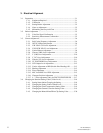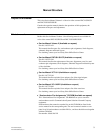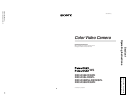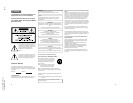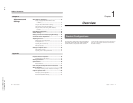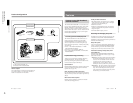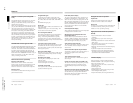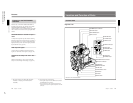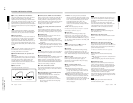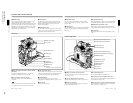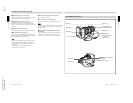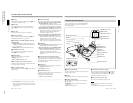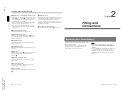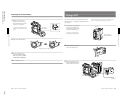
1-6
DXC-D35/D35WS(UC)
DXC-D35P/D35WSP(CE) V1
Chapter 1 Overview
10
Chapter 1 Overview
ClipLink™ Function (when using DSR-
1/1P)
The ClipLink function can be used at every step from
acquisition to editing. Information necessary for
editing is recorded when shooting to ensure fast and
efficient editing operations.
When you set a recording start (Rec IN) point or when
you press the TAKE button to set a Mark IN point, the
video image at that point is recorded on the tape in
compressed form as an Index Picture. In addition, the
time codes for such editing points (Mark IN/Mark
OUT points or cue points) are recorded along with
other editing point data (such as the cassette number
and scene number) into cassette memory (as ClipLink
log data). Unsuccessful scenes containing faults can
also be marked in cassette memory as “NG”, so that
only the good scenes are taken up from cassette
memory when editing.
Dockable with various types of VTRs
The DXC-D35/D35P/D35WSL/D35WSPL docks with
the DSR-1/1P DVCAM VTR to configure
a
digital
camcorder. It also docks with the PVV-3/3P Betacam
SP VTR to configure a Betacam SP camcorder. In
addition, the DXC-D35/D35P/D35WSL/D35WSPL
docks with the EVV-9000/9000P Hi-8 VTR. Using an
adaptor (not supplied), it is also able to dock with a
variety of existing S-VHS VTRs.
New Functions boost operability
EZ (easy) mode function
When there isn’t time to check the camera head
settings, simply press the EZ mode button to start the
auto adjustment function using standard settings.
There is no need to lose a shot for lack of setup time.
EZ (easy) focus
Press the EZ focus button before shooting to ensure a
quick and accurate focus.
..........................................................................................................................................................................................................
1) DPR = Dual Pixel Readout
Programmable gain
The amount of gain relative to the GAIN switch
setting (H, M, or L) can be programmed as –3 dB, 0
dB, 3 dB, 6 dB, 9 dB, 12 dB, 18 dB, 18 dB+DPR
1)
, 24
dB,
24 dB+DPR and hyper gain.
Hyper gain
Hyper gain (36 dB or 42dB, i.e. about 60 times or 120
times greater than
0 dB) can be easily set via one switch setting. This
can also be done from remote equipment.
Auto tracing white balance
This function automatically traces the white balance,
which constantly changes as lighting conditions
change. Auto tracing white balance is especially
useful when there is no time to manually adjust the
white balance or when shooting moves between indoor
and outdoor locations.
Total level control system (TLCS)
Even if the incoming light exceeds the range in which
the standard auto iris can control exposure, the auto
gain control (AGC) or auto exposure (AE) backs up to
ensure proper exposure.
Dual pixel readout (DPR)
When the gain is set to either 18 dB or 24 dB, the gain
setting can be doubled (6 dB up) without increasing
the noise level.
Recording time display
Recording time can be displayed in either of the
following modes.
•Total recording time for all cuts
•Total recording time for current cut
Viewfinder super detail
Video signals for the viewfinder are mixed with DTL
signals to make focusing easier.
Features
Chapter 1 Overview
Chapter 1 Overview
11
Dual zebra pattern display
Two types of zebra patterns, zebra 1 and zebra 2 can
be displayed simultaneously or independently. The
zebra 1 can be set to the levels ranging from 70 to 90
IRE on the DXC-D35/D35WSL (or from 70 to 90% on
the DXC-D35P/D35WSPL) and the zebra 2 indicates
the levels of 100 IRE for the DXC-D35/D35WSL or
more (or the levels of 100% or more for the DXC-
D35P/D35WSPL).
Color temperature display
When reading the white balance, the color temperature
is displayed on the viewfinder screen.
Switching the color temperatures for the
preset white balance
You can select the preset white balance at 3200 K
(default) or 5600 K (default) by setting the FILTER
control. The preset white balance can be changed to
other value through menu setting (see page 59).
Video monitor output with text
The video signal with text superimposed that is shown
in the viewfinder can also be output to an external
video monitor.
Camera head microphone output indicator
An indication 9 appears in the viewfinder whenever a
signal is being output from the camera head’s
microphone.
1-kHz reference signal output
Along with a color bar, a 1-kHz reference signal can
also be output.
Freeze mix function (when using DSR-1/1P)
The freeze mix function superimposes any previously
recorded still picture on the viewfinder screen to
facilitate framing the subject when reshooting the
scene.
Edit Search Function (when using DSR-1/1P)
When using the DXC-D35/D35P/D35WSL/D35WSPL
with the DSR-1/1P, pressing the EDIT SEARCH
buttons allow the tape to play back in search mode.
Set either of two playback speeds.
Designed for ease of operation
Dynafit Pad
Thanks to the Dynafit Pad which fits well to the
shoulder, the camera is stable on the shoulder.
Slide cover
The slide cover can hide the switches and buttons that
are seldom used during shooting. The cover can be
locked so as not to open during shooting.
High-performance viewfinder (DXF-801/
801CE)
•High resolution (600 TV lines of horizontal
resolution)
•Large-diameter eye cup for easier viewing and
focusing
•PEAKING potentiometer for vertical and horizontal
detail control
•Two indicators can be used as TALLY indicators.
•Tough die-cast aluminum body
•DISPLAY switch that can turn the character display
on and off
•Light that can light the lens control elements
•Switching the aspect ratio automatically between
16:9 (wide screen) and 4:3 (standard screen) when
used with the DXC-D35WSL/D35WSPL
VTR data display
When connected to a VTR, the DXC-D35/D35P/
D35WSL/D35WSPL is able to display the following
data on the viewfinder screen.
•Time values (counter, time code, or user bit vales)
•VTR audio levels
•Remaining tape time
•VTR operation mode
•Remaining battery capacity (when using an Anton
Bauer Intelligent Battery System)
•ClipLink information (when using the DSR-1/1P)



